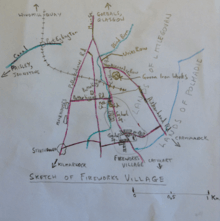Fireworks Village
| Govan Colliery Houses | |
| Fireworks Village | |
 Sketch of Fireworks Village and the surrounding area: Strathbungo, Port Eglington and Govan Iron Works |
|
 Govan Colliery Houses |
|
| Population | 600 (1841)[1] |
|---|---|
| OS grid reference | NS895875 |
| Civil parish | Govan |
| Council area | Glasgow |
| Shire county | Lanarkshire |
| Country | Scotland |
| Sovereign state | United Kingdom |
| EU Parliament | Scotland |
Coordinates: 55°50′09″N 4°15′23″W / 55.83583°N 4.25639°W
Fireworks village, also known as Govan Colliery Houses, was a company village belonging to the Dixon family who ran the Govan Iron Works and Govan Colliery. The inhabitants were chiefly coal miners and their families who worked in the Govan Colliery. The company also built a Methodist church and a school.
History
The Govan Colliery, also known as the Little Govan Colliery, was worked from at least the 18th Century, William Dixon[2] having started there as colliery manager in the 1770s. The colliery and later the iron works remained in the control of the Dixon family from then until 1873 when it became a limited company William Dixon Ltd. and was no longer a family firm.
Between 1783 and 1785 the Govan Waggonway was built between the colliery and the Clyde.[3]
In 1811 Dixons built a waggonway linking the colliery with the Glasgow, Paisley and Johnstone Canal at Port Eglington, the Glasgow terminus. The canal was opened in 1810.
In 1820 Dixons bought the lands of Govanhill and the colliery.
In 1830 an Act of Parliament authorized the construction of the Polloc and Govan Railway(sic) which was completed in 1840. It extended the old tramway past Port Eglington to Windmill Quay on the Clyde in one direction and to Rutherglen in the other direction.[4] The line now forms part of the West Coast Main Line.
In the 1860's the first tenements were built, which later formed the Burgh of Govanhill. The houses belonging to Fireworks were gradually demolished. In 1906 Garden Square was demolished, the last of the old Fireworks Village.
Geography
The village lay about 4 km south of Glasgow City Chambers, just to the North of the junction of the turnpike between Glasgow and Carmunnock via Cathcart (now Cathcart Rd.) and the Rutherglen to Paisley road (now Allison St.). What is now Bankhall St. lies in the middle of the old village, which consisted of Hosie's Land and Garden Square to the West of the turnpike and Engine Row, the Back Close, Carter Row, the Cuddy Row and Graham Square to the East.
There was an outlier to the North called School Square (lying between Calder St. and Govanhill St. on the West side of the main road) after the Govan Colliery School, also built by Dixons, which lay even further North.[5]
Amenities
- Methodist church
- School
- Reading room with copies of national newspapers
See also
References
- Lewis, Samuel (1846). "A Topographical Dictionary of Scotland"
- Glasgow University Archive Service. "Records of the Poloc and Govan Railway and the Clydeside Junction Railway, Scotland"
- Smart, Aileen (2002). "Villages of Glasgow, Vol 2",
- MacLehose,James (1886) "Memoirs and portraits of one hundred Glasgow men"